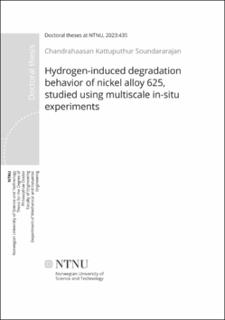| dc.contributor.advisor | Johnsen, Roy | |
| dc.contributor.advisor | Iannuzzi, Mariano | |
| dc.contributor.author | Soundararajan, Chandrahaasan Kattuputhur | |
| dc.date.accessioned | 2024-01-18T07:14:37Z | |
| dc.date.available | 2024-01-18T07:14:37Z | |
| dc.date.issued | 2023 | |
| dc.identifier.isbn | 978-82-326-7571-5 | |
| dc.identifier.issn | 2703-8084 | |
| dc.identifier.uri | https://hdl.handle.net/11250/3112318 | |
| dc.description.abstract | Nickel-based alloys are widely used in the oil and gas industries as safety critical components owing to its high strength and corrosion resistance properties. However, they are susceptible to hydrogen embrittlement (HE), a phenomenon that weakens metallic materials, leading to unexpected and catastrophic failures. The interaction between hydrogen and material defects plays a crucial role in this degradation process. This study investigates the effect of hydrogen on the plastic behavior of nickel-based alloy, Alloy 625, at different length scales to gain insights into this interactions. The study utilized in-situ Acoustic emission (AE) monitoring during tensile tests to observe hydrogen influence on macroscale deformation and fracture behavior in real-time. In-situ electrochemical nanoindentation (ECNI) was used to probe local mechanical properties at the nanoscale.
The tensile test revealed progressive reduction in fracture elongation and increased strength response with increase in hydrogen concentration. The AE signals from tensile tests were characterized using spectral analysis based non-supervised clustering procedure to separate the contribution of dislocation slip and microcracks into the deformation and fracture processes. The results reveal that the relative mobile dislocation density increases with increasing hydrogen concentration, as hydrogen reduces the critical stress for Frank Reed source activation and loop expansion. Additionally, hydrogen-charged samples show a reduction in average dislocation velocity, indicating hydrogen solute pinning the dislocations results in hardening behavior. The study also unveils the conditions and details of the kinetics of the hydrogen-assisted crack nucleation and propagation process in hydrogen-charged samples. Postmortem characterization of crack propagation path reveals a transition from the transgranular to the intergranular type, which is attributed to the hydrogen concentration profile depending on the loading conditions.
To understand the hydrogen effect on the nanomechanical response of the annealed nickel alloy, nanoindentation tests with in-situ charging and in-situ scanning probe microscopy (SPM) imaging was carried out. The results show reduced pop-in load, indicative of hydrogen-enhanced dislocation nucleation, resulting from reduction in dislocation line energy or stacking fault energy. The study estimated the hydrogen contribution to the lattice frictional stress using the Nix-Gao model and found that the hydrogen-induced frictional stress had a linear dependence with solute concentration, implying the solute drag effect. The study also reveal hydrogen-induced surface slip line formation during severe charging; the hardness measured after subsequent desorption exhibit softening behavior, which is attributed to non-equilibrium vacancies generated during charging and the subsequent stabilization by hydrogen.
Finally, the study examines the effect of hydrogen on pre-strained nickel alloy using ECNI technique. The results show hydrogen-induced hardening during charging and softening behavior during desorption. The hardening is due to the collective influence of pre-existing defects and hydrogen solutes impeding the dislocation motion. Moreover, the enhanced hydrogen uptake reduces the SFE locally at the surface and promotes mechanical twinning, resulting in increased hardness. On the other hand, the pre-strained samples exhibit softening behavior during desorption, which is attributed to irreversible microstructural changes caused by hydrogen-enhanced vacancies. This study highlights the permanent modification of the microstructure by hydrogen solute, which could lead to autocatalytic defect generation and ultimately failure. | en_US |
| dc.language.iso | eng | en_US |
| dc.publisher | NTNU | en_US |
| dc.relation.ispartofseries | Doctoral theses at NTNU;2023:435 | |
| dc.relation.haspart | Paper 1: Kattuputhur Soundararajan, Chandrahaasan; Myhre, Aleksander Omholt; Sendrowicz, Aleksander; Lu, Xu; Vinogradov, Alexei. Hydrogen-induced degradation behavior of nickel alloy studied using acoustic emission technique. Materials Science & Engineering: A 2023 ;Volum 865 https://doi.org/10.1016/j.msea.2023.144635 This is an open access article under the CC BY license (http://creativecommons.org/licenses/by/4.0/). | en_US |
| dc.relation.haspart | Paper 2: Kattuputhur Soundararajan, Chandrahaasan; Wang, Dong; Vinogradov, Alexei. Effect of hydrogen on nanomechanical properties of Inconel 625 studied using in-situ electrochemical nanoindentation technique. Journal of Alloys and Compounds 2023 ;Volum 948. https://doi.org/10.1016/j.jallcom.2023.169742This is an open access article under the CC BY license (http://creativecommons.org/licenses/by/4.0/). | en_US |
| dc.relation.haspart | Paper 3:
Kattuputhur Soundararajan, Chandrahaasan; Lu, Xu; Wang,Dong; Vinogradov, Alexei.
Distinct evidence of hydrogen-enhanced defects formation on pre-strained nickel alloy 625 during in-situ electrochemical nanoindentation test | en_US |
| dc.title | Hydrogen-induced degradation behavior of nickel alloy 625, studied using multiscale in-situ experiments | en_US |
| dc.type | Doctoral thesis | en_US |
| dc.subject.nsi | VDP::Technology: 500::Mechanical engineering: 570 | en_US |

